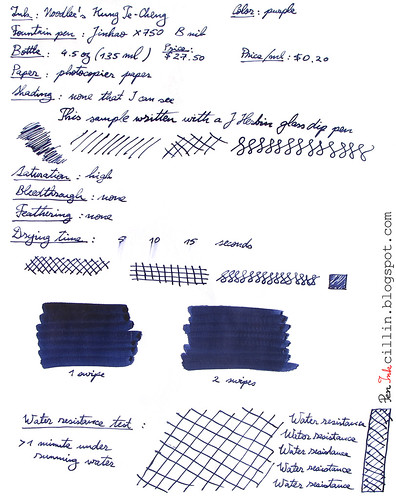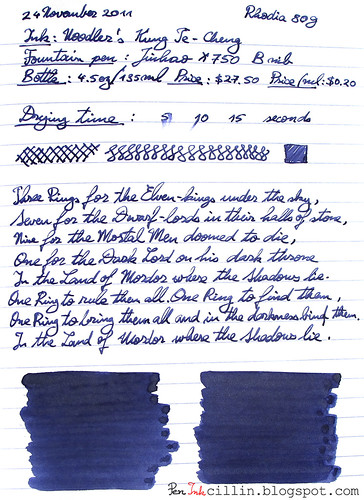Noodler's Kung Te-Cheng is a very interesting ink. It is apparently reproduced from an ancient Chinese formula and it is meant to mimic the color of the inks used by Chinese emperors. If you ask me, I tend to agree that this color seems particularly royal. The ink itself is purple but it can trick you into thinking it is blue. It's in fact a purple-blue combination and, depending on how the light shines on it and the paper used, you could swear it's one or the other. I will classify it as purple because that is how it is designated.
Kung Te-Cheng is bulletproof which means it is resistant to a forger's chemicals and, more importantly, to water.
I tested Kung Te-Cheng in my Jinhao X750 with a broad nib.
Bottle
This ink only comes in 4.5oz (133ml) bottles, and it is rather pricy compared to other Noodler's inks. One bottle costs about $27.50 (or $0.20 per milliliter). On the other hand you do get some extra goodies with it, namely an eyedropper Platinum Preppy with an interchangeable ballpoint tip and also a brush pen.
Noodler's recommends that you use Kung Te-Cheng only with the provided pens and for good reason. You will see further on why.
Color and saturation
Kung Te-Cheng, as mentioned, is a mysterious blue-purple which seems to change its color depending on how you view it. Paper makes a difference and so does the light which shines on it. To me, it looks more purple on Rhodia than on photocopy paper. That's probably due to the fact that Rhodia absorbs less of it than photocopy paper.
Saturation is average to high. This is not a bright ink by all means but it is dark and opaque and it does stand out.
Shading
Noodler's Kung Te-Cheng doesn't show any shading to speak of, at least not when used with the broad nib of the Jinhao pen. With the q-tip it gets darker in places where the ink has the chance to pool up but I can't exactly call that shading.
Feathering
Kung Te-Cheng behaves very well in this respect. I haven't noticed any feathering, even on the cheap photocopier paper.
Bleedthrough
Surprisingly, bleedthrough is well contained, though if you press hard enough on the nib it will show through on cheap paper.
Flow and lubrication
Here's where some of Kung Te-Cheng's deficiencies start to show. I found that this ink is very dry flowing, especially in the Jinhao which is not exactly a champion of good flow. While I love the ink's other properties (color and water resistance), the fact that it felt as dry as sandpaper when writing with it helped to tone down some of my enthusiasm.
In addition I found that it tended to dry up in the pen and it also produced a fair amount of nib creep.
Drying time
Considering the above, it's not a big surprise that Noodler's Kung Te-Cheng dries quickly on Rhodia paper and even quicker on photocopy, within 10-15 seconds.
Smearing when dry
I haven't noticed any smearing but that's also helped by the fact that the ink is absorbed really well into the paper.
Water resistance
Needless to say, Noodler's Kung Te-Cheng is very resistant to water, in addition to other chemicals. After more than 1 minute under running water it remains rock-solid.
Conclusion
Noodler's Kung Te-Cheng is one of those classy inks that are quite beautiful to behold but still manage to be flawed. It can certainly be used in a business setting but in any case I would recommend a fountain pen which is very wet flowing, to compensate for its dryness. If strong chemical smell bothers you a lot you might also give Kung Te-Cheng a pass. While the chemical smell it emits is not overpowering, it is certainly there and it becomes evident when you start laying it down on paper. Water resistance is very often a good thing and in this aspect Kung Te-Cheng is a winner but this is offset by its tendency to dry inside pens and potentially ruin them in the very long run if you forget to clean them. I won't be buying a bottle of this ink but it is definitely worth to try at least a sample. I'm pretty sure that for art it shines, especially when used with a brush pen. Noodler's Kung Te-Cheng does a good job of capturing the mystery and nostalgia of Imperial China.
Following are the two samples I wrote on photocopy paper and Rhodia 80g, respectively.
Kung Te-Cheng is bulletproof which means it is resistant to a forger's chemicals and, more importantly, to water.
I tested Kung Te-Cheng in my Jinhao X750 with a broad nib.
Bottle
This ink only comes in 4.5oz (133ml) bottles, and it is rather pricy compared to other Noodler's inks. One bottle costs about $27.50 (or $0.20 per milliliter). On the other hand you do get some extra goodies with it, namely an eyedropper Platinum Preppy with an interchangeable ballpoint tip and also a brush pen.
Noodler's recommends that you use Kung Te-Cheng only with the provided pens and for good reason. You will see further on why.
Color and saturation
Kung Te-Cheng, as mentioned, is a mysterious blue-purple which seems to change its color depending on how you view it. Paper makes a difference and so does the light which shines on it. To me, it looks more purple on Rhodia than on photocopy paper. That's probably due to the fact that Rhodia absorbs less of it than photocopy paper.
Saturation is average to high. This is not a bright ink by all means but it is dark and opaque and it does stand out.
Shading
Noodler's Kung Te-Cheng doesn't show any shading to speak of, at least not when used with the broad nib of the Jinhao pen. With the q-tip it gets darker in places where the ink has the chance to pool up but I can't exactly call that shading.
Feathering
Kung Te-Cheng behaves very well in this respect. I haven't noticed any feathering, even on the cheap photocopier paper.
Bleedthrough
Surprisingly, bleedthrough is well contained, though if you press hard enough on the nib it will show through on cheap paper.
Flow and lubrication
Here's where some of Kung Te-Cheng's deficiencies start to show. I found that this ink is very dry flowing, especially in the Jinhao which is not exactly a champion of good flow. While I love the ink's other properties (color and water resistance), the fact that it felt as dry as sandpaper when writing with it helped to tone down some of my enthusiasm.
In addition I found that it tended to dry up in the pen and it also produced a fair amount of nib creep.
Drying time
Considering the above, it's not a big surprise that Noodler's Kung Te-Cheng dries quickly on Rhodia paper and even quicker on photocopy, within 10-15 seconds.
Smearing when dry
I haven't noticed any smearing but that's also helped by the fact that the ink is absorbed really well into the paper.
Water resistance
Needless to say, Noodler's Kung Te-Cheng is very resistant to water, in addition to other chemicals. After more than 1 minute under running water it remains rock-solid.
Conclusion
Noodler's Kung Te-Cheng is one of those classy inks that are quite beautiful to behold but still manage to be flawed. It can certainly be used in a business setting but in any case I would recommend a fountain pen which is very wet flowing, to compensate for its dryness. If strong chemical smell bothers you a lot you might also give Kung Te-Cheng a pass. While the chemical smell it emits is not overpowering, it is certainly there and it becomes evident when you start laying it down on paper. Water resistance is very often a good thing and in this aspect Kung Te-Cheng is a winner but this is offset by its tendency to dry inside pens and potentially ruin them in the very long run if you forget to clean them. I won't be buying a bottle of this ink but it is definitely worth to try at least a sample. I'm pretty sure that for art it shines, especially when used with a brush pen. Noodler's Kung Te-Cheng does a good job of capturing the mystery and nostalgia of Imperial China.
Following are the two samples I wrote on photocopy paper and Rhodia 80g, respectively.

